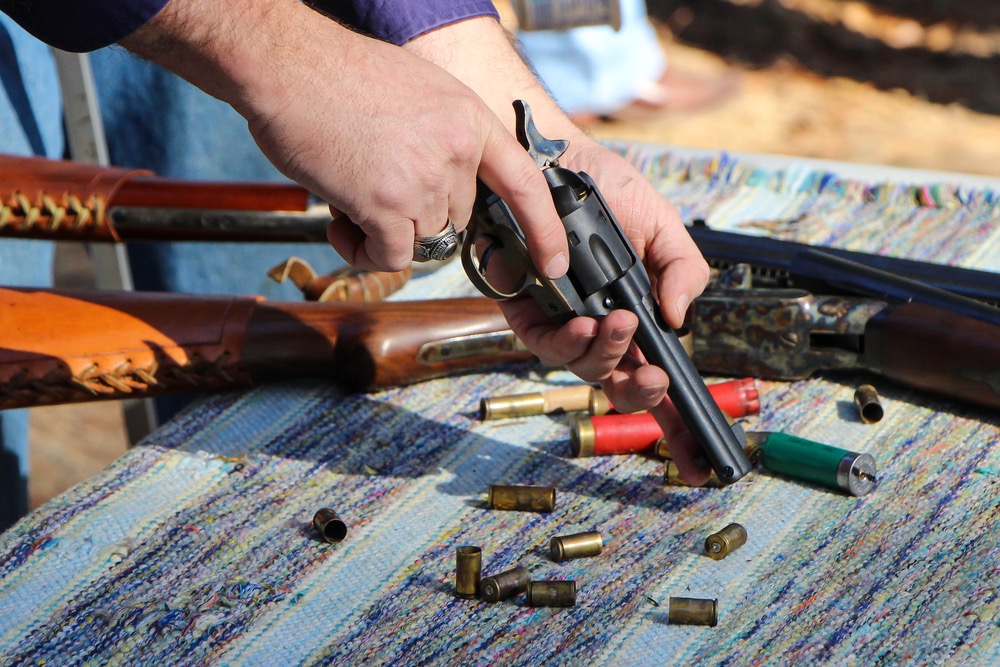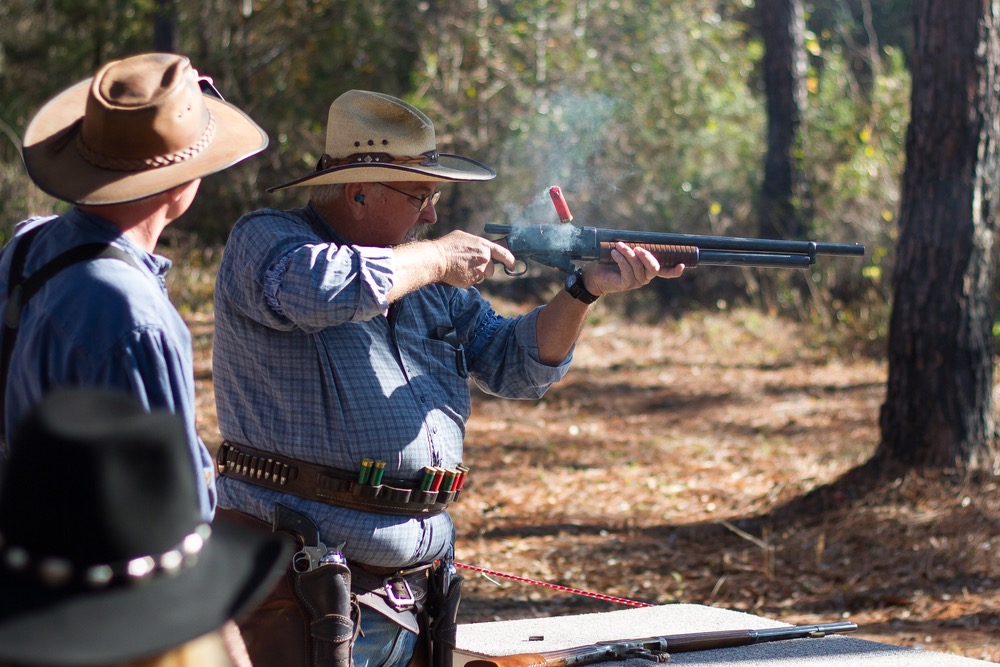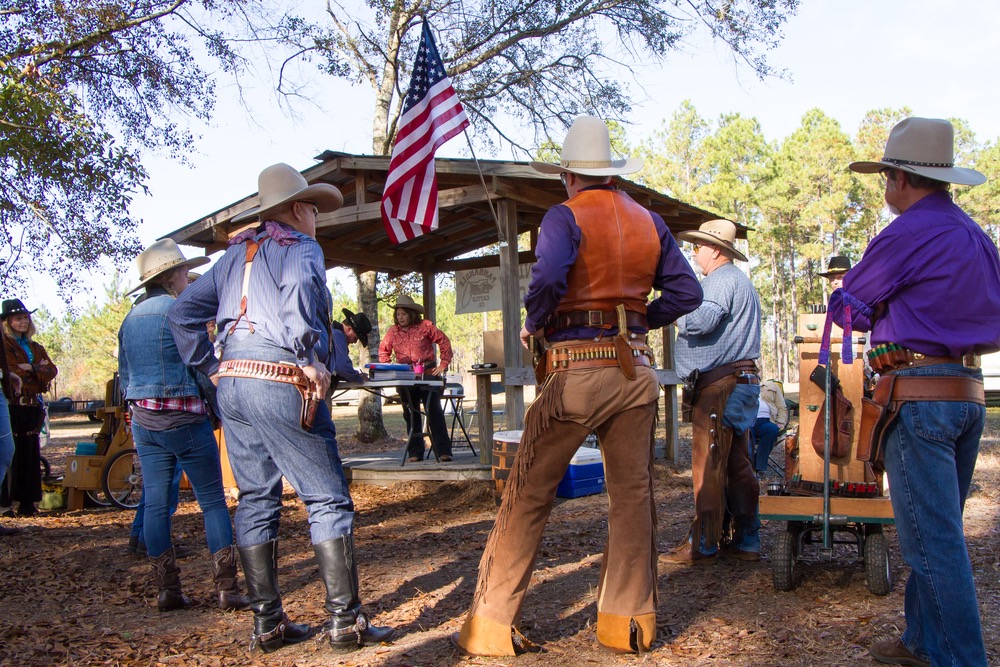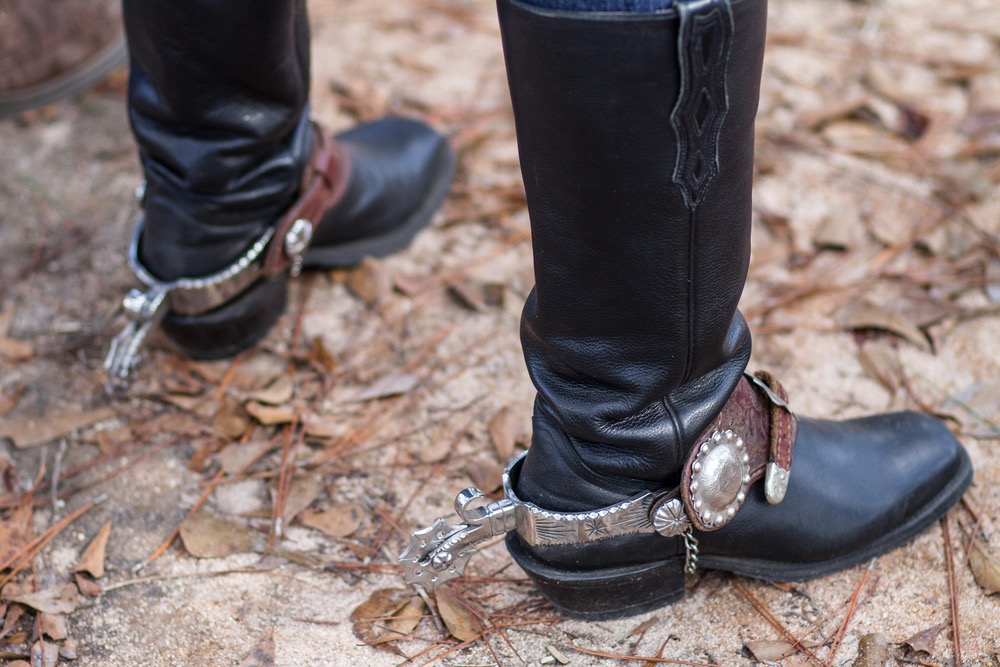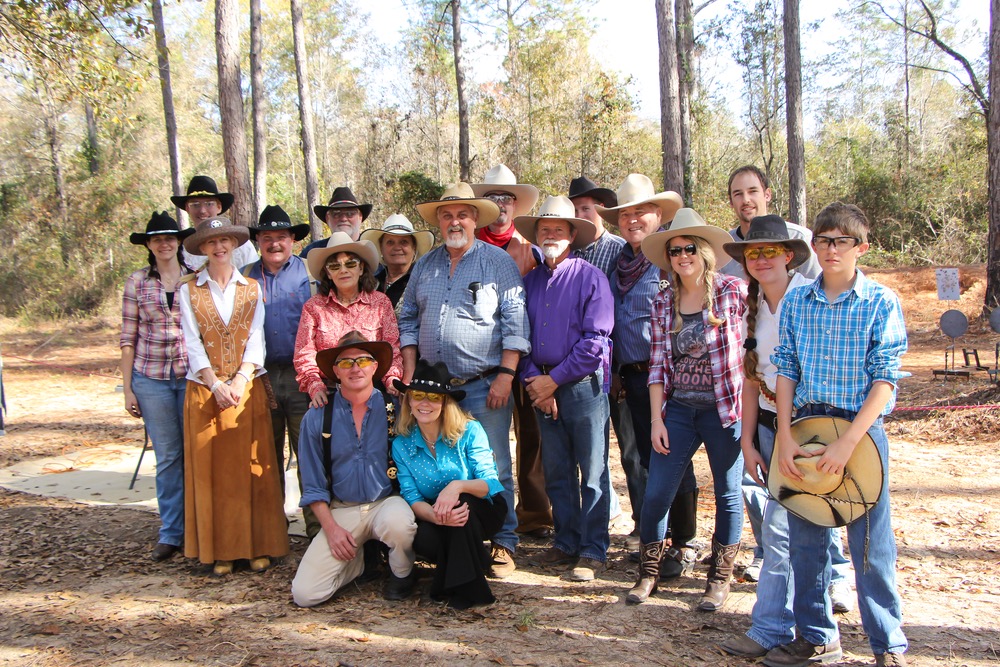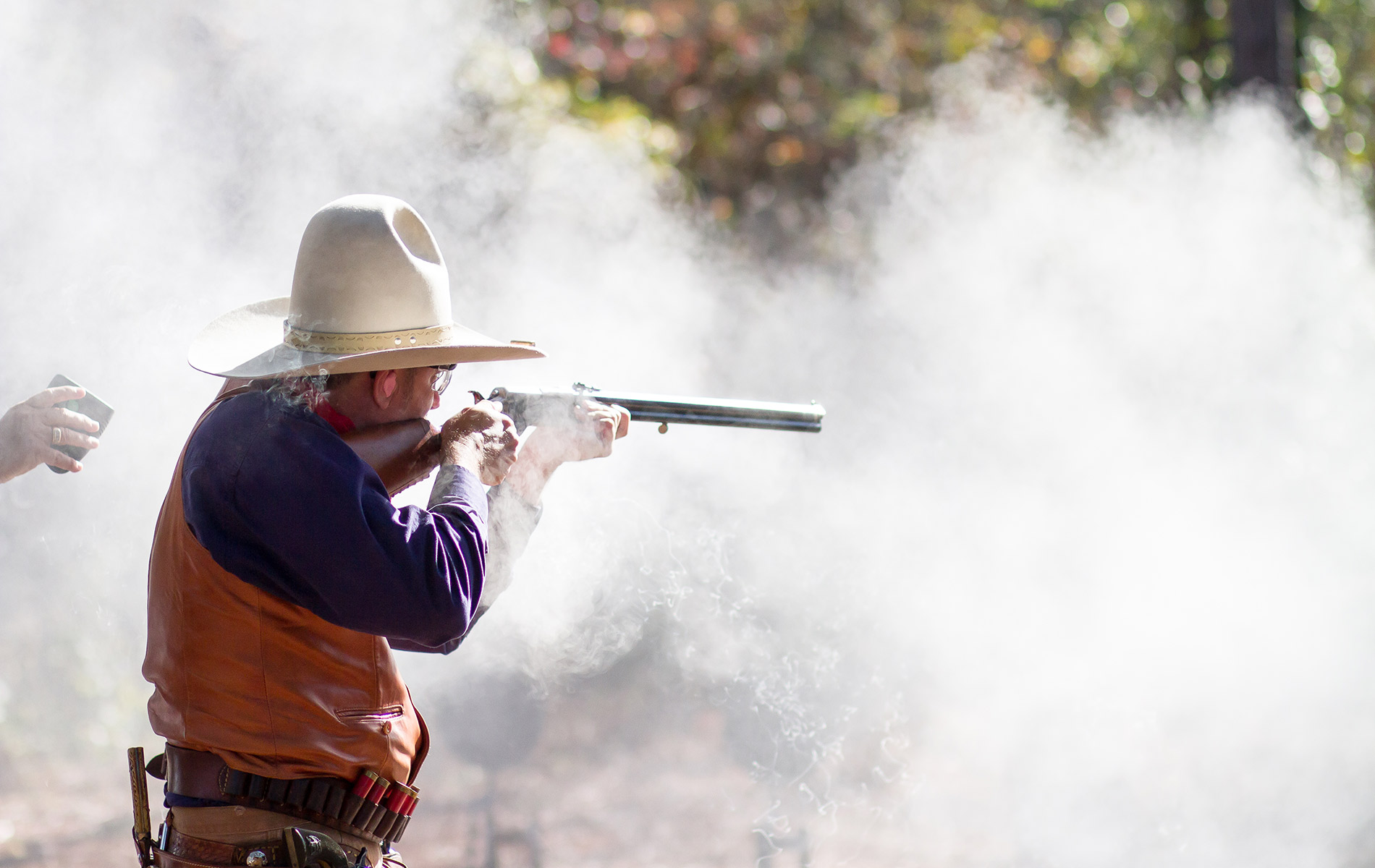
vie-magazine-cowboy
Cowboy Culture
Shootin’ with the Panhandle Cattle Company
By Jordan Staggs | Photography by Fletcher Isackst
A thunderous crack echoed throughout the woods as a flash followed by a thick cloud of white smoke spewed from his rifle barrel. Trading his rifle for a shotgun from the table before him, Michael “Hollifer A. Dollar” Murphy bobbed and weaved to take aim once more at the targets now obscured by the cloud of smoke clinging to the cool autumn air.
“He’s doing the cowboy dance,” Barbara “Buckskin Barb” Sims laughed as she watched the rest of the round. A sharp ping pierced the air as each shotgun target bit the dust: one, two, three, four. Hollifer stepped back from the range and admired his handiwork as the gun smoke cleared. A clean stage—no misses and no penalties. He moved on to the next table, where his revolvers, rifle, and shotgun would be checked to make sure all chambers were empty and any live ammunition was properly stowed before he rejoined the throng of onlookers. Meanwhile, “Panama John” began shooting his stage of the competition.
Around the clearing at a hunting preserve in Chipley, Florida, ladies and gentlemen in their best spurs, tallboy hats, and gun belts watched as each shooter stepped up to the ropes and fired at metal targets of all shapes, sizes, and distances. This was the beginning of Panhandle Cattle Company’s December shooting match.
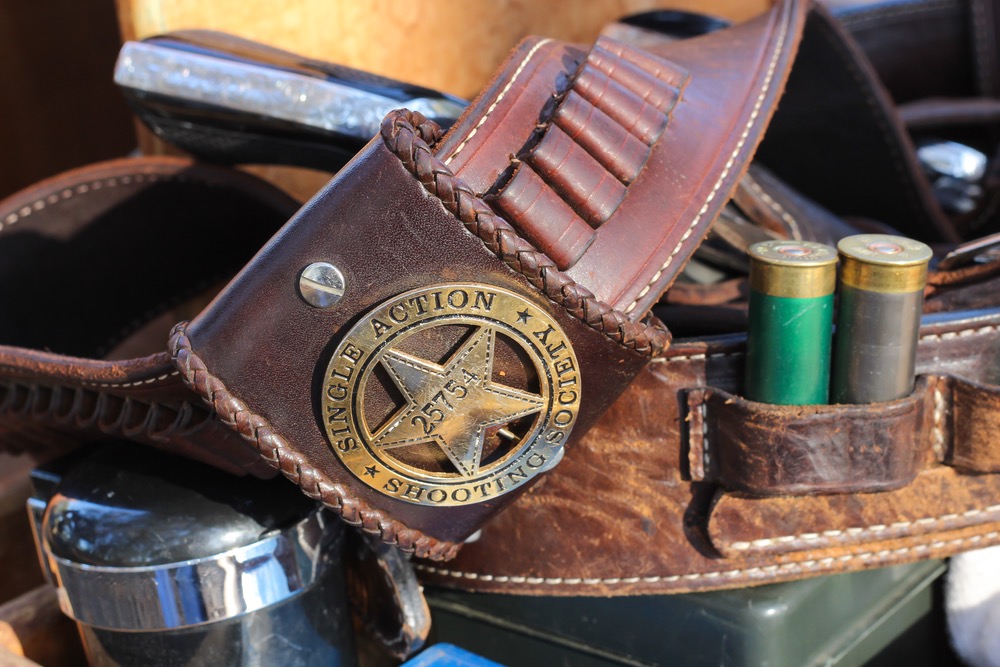
The Single Action Shooting Society has club affiliates worldwide and holds many competitions for cowboy action shooting each year.
The fourth Saturday of every month, the posse meets to engage in a competition of speed, skill, and style. Competitors shoot six stages, each with its own unique—and often humorous—storyline attached. Shooters of all ages and skill levels come out to test their marksmanship, but mostly to just have fun. Panhandle Cattle Company (PCC), a club affiliated with the Single Action Shooting Society, is dedicated to the love of cowboy action shooting and the community that accompanies the sport. It is not about winning the prize.
“The camaraderie is astounding,” said Dale Sims, a.k.a. “Desperado Dale,” president of PCC. Dale is a former lieutenant with the Broward Sheriff’s Office, and he was a firearms instructor for the state, the FBI, and the National Rifle Association. “Everyone is just out here to have a good time, and these are some of the nicest people you’ll ever meet. Our organization allows adults to become kids again and play cowboys, but with real guns and real bullets.”
Cowboy action shooting has grown vastly in popularity since the 1980s.
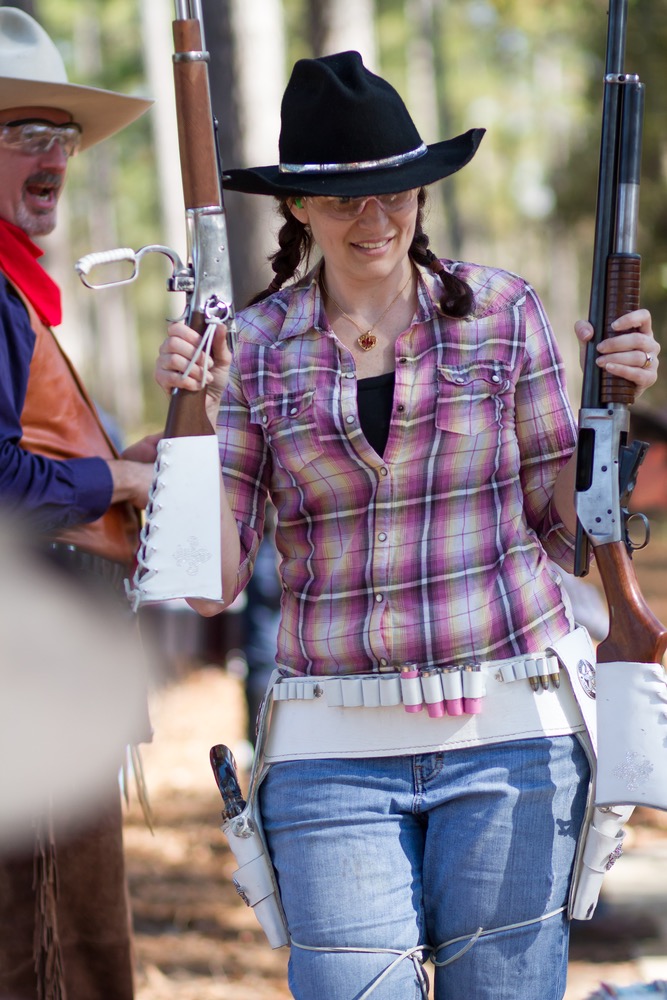
The ladies of Panhandle Cattle Company, such as “Flirt D. Lee,” all have their own cowgirl style.
Cowboy action shooting has grown vastly in popularity since the 1980s, when a fellow who went by the alias Judge Roy Bean—named so after the eccentric late-1800s saloonkeeper and justice of the peace in Val Verde County, Texas—established the shooting society to promote single action competitive shooting, wherein the hammer of the pistol must be pulled back before every shot. “From there, it became an international sport,” said Desperado Dale. “There were over five hundred shooters at the world championship match in New Mexico this year. We met shooters from Australia, Europe—from all over the world.”
As one can imagine in a competition where firearms are involved, safety is the biggest factor when it comes to the rules. A briefing of all the safety procedures precedes each match. This includes ammunition loading and unloading, requirement of eye protection in case lead particles ricochet off the targets, and the One-Seventy rule, which requires shooters to keep their firearms trained in a downrange direction with a limit of one hundred seventy degrees of horizontal angle. Any shooter who breaks the One-Seventy rule by aiming a firearm past the limit, and therefore in the direction of spectators, is automatically disqualified. Accidental or not. Hasta la vista!
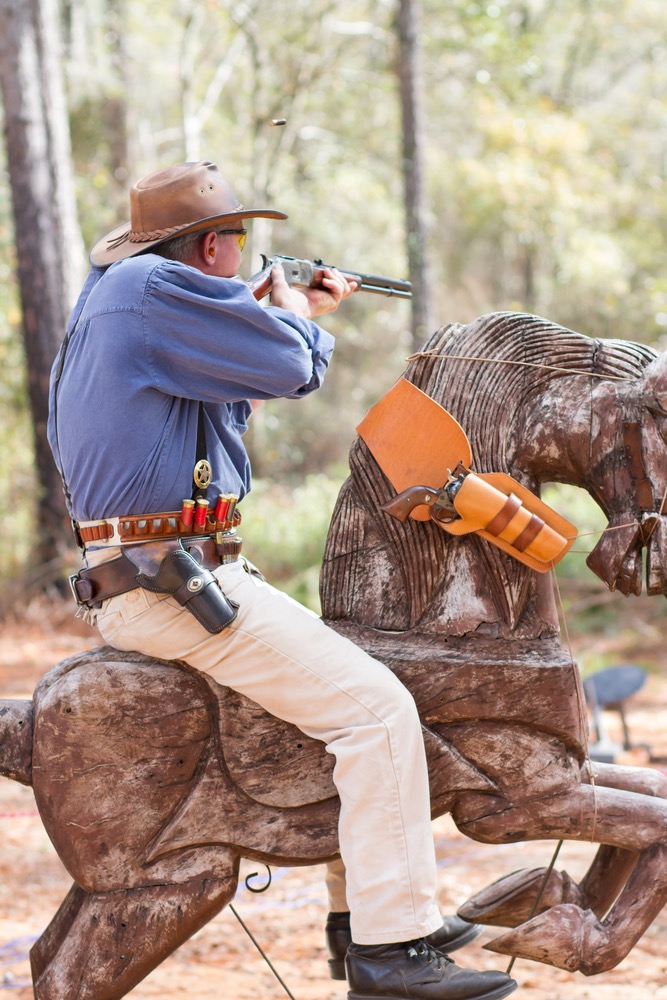
Different props, including “Pokey” the horse, are used to facilitate the story for each shooting stage.
Each shooter competes in a specific category defined by age, gender, or skill level. Scores are compiled after each round of shooting based on time and accuracy. Five- or ten-second penalties are given if a competitor misses the target, shoots the targets in the wrong order, or mixes up the order in which the firearms are to be used. The overall winner is awarded Top Gun for the match, an honor that is commemorated by a ribbon, a slap on the back, and, of course, braggin’ rights. “We never compete for money,” said Hollifer A. Dollar, who began shooting cowboy action in May 2011. “That keeps the professional shooters out. Here you’ll see times from fifteen seconds to sixty seconds, but everybody’s having a great time. It’s competitive, but people aren’t trying to get an edge up on you.” The sport is more about competing with one’s own times and trying to improve, which is what everyone in the club wants to see. They are constantly offering tips to help one another between rounds. “If you have a gun break during competition, five people will offer you one,” Hollifer said. “That’s the cowboy way.”
The shooters of the PCC are more than just cowboys, though. They are artisans as well. Many of the club members do their own leatherwork to craft gun belts, holsters, buttstock covers, and more, in intricate detail. The sport is all about having fun, and doing it in true cowboy style. Just ask “Flirt D. Lee,” the sassy cowgirl of the PCC who dons white leather duds and uses pink shotgun shells for matches. “I may not be the best shooter,” she said with a grin, “but I look good doing it!”
Cowboy action shooting continues to grow in popularity, and the PCC hopes to expand its monthly matches by improving upon the shooting range in Chipley, where they recently relocated from Port St. Joe. Future plans for the range allow for a storage building for targets and range equipment, including the life-size wooden rocking horse on which competitors are mounted for the last stage of competition. Buckskin Barb dubbed the horse “Pokey,” “since he mostly just stands still.” Other range improvements will include backdrops such as Old West–style storefronts and saloons, which will further lend to the cowboy ambience.
The overall winner is awarded Top Gun for the match, an honor that is commemorated by a ribbon, a slap on the back, and, of course, braggin’ rights.
Panhandle Cattle Company encourages anyone who is interested to come out and try cowboy action shooting. “It’s very user-friendly,” said Hollifer. “You can just jump in with both feet and try it. We’ve had first-time shooters go out and shoot an entire match. One thing you have to understand is it is extremely addictive.”
To learn more about cowboy action shooting and the Single Action Shooting Society, visit sassnet.com. For more information on PCC, and to view their match location and schedule, visit panhandlecattleco.com or like Panhandle Cattle Company on Facebook. Happy trails!
— V —
Share This Story!
KEEP UP WITH THE LATEST STORIES FROM VIE



